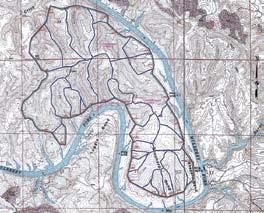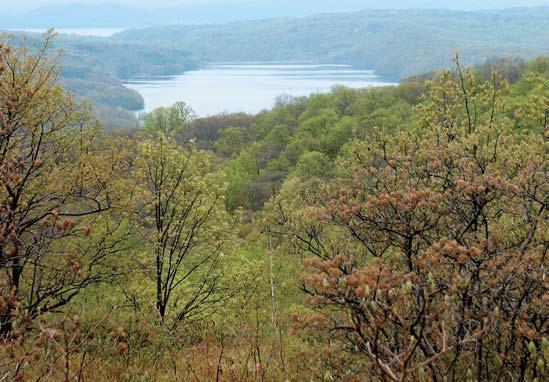
5 minute read
Threat to Birmingham Water Supply
Shepherd Bend Mine: Threat to Birmingham Water Supply
By Black Warrior Riverkeeper
»Sh eph erd Bend Mine, a proposed coal mine along the Black Warrior River’s Mulberry Fork, is right across the river from the Birmingham Water Works Board’s drinking water intake. Putting a massive 1,773-acre strip mine adjacent to one of Birmingham’s major drinking water intakes is ludicrous. This mine proposes 29 wastewater outfalls into the river and its tributaries.
The entity applying for this mine’s wastewater discharge permit through the Alabama Department of Environmental Management (ADEM) is Shepherd Bend LLC. Its Managing Member, Donald M. Baxter, is also the Managing Member of Quinton Mining LLC, which violated its discharge permit at another mine in the same area more than 200 times in 2005 and 2006. ADEM’s fine was a mere slap on the wrist. Paying ADEM’s meager fines is a small cost of doing business compared to the cost of installing proper pollution controls.
There is every reason to believe permit compliance will be an issue at Shepherd Bend Mine as well. When a coal strip mine violates its permit, high amounts of total suspended solids, or muddy water, and heavy metals such as iron, aluminum and manganese, among other pollutants, are discharged. If there is a location where a coal mine should be denied a permit, this is it. Our drinking water is too important.
The Mulberry Fork supplies Birmingham with tens of millions of gallons of water each day. Watershed protection is the key component to a healthy water supply, especially for the land immediately adjacent to the water intake. Once watershed protections are lost and pollution is inevitable, chemical treatment of the water becomes necessary. It is much more costly to treat polluted water than clean water. The Birmingham Water Works is concerned about this mine’s potential to pollute our water and raise treatment costs.
Property owners on Shepherd Bend who were listed in the permit application are as follows: Ala-West LLC, the University of Alabama, Dr. Heaton, Soterra LLC, Paul Blalock, Nathaniel Key, Ralph Brasfield, John Hollis and Gail Beaird. The University of Alabama owns a large chunk of the proposed area, believed to be near 1,300 acres. We urge these property owners to consider a use which will be more protective of our drinking water supply and local communities. Many locals see opportunities for community
B rooke
N elson
of ADEM

co u rtesy
revitalization, embracing the river as an asset. Allowing this mine to destroy a major bend of the river would be a devastating blow to such plans.
Native Americans used the river here for centuries while respecting it and the land that drains to it. There are six known archaeological sites throughout Shepherd Bend. The Alabama Historical Commission has therefore asked for continued study of the site for additional cultural resources prior to disturbance of any kind.
Black Warrior Riverkeeper submitted comments on the ADEM National Pollutant Discharge Elimination System wastewater discharge permit during the public comment period. Our comments included a request for an ADEM public hearing on behalf of our members and more than 50 individuals in the area. We await ADEM’s response to our comments, as well as their decision on allowing a hearing where the public can voice concerns. Should a hearing be denied, ADEM will surely give this mine a permit. We are monitoring this mine’s progress closely.
Shepherd Bend on the Black Warrior River’s Mulberry Fork.
Mine’s boundary in black; pollution outfalls in red; water intake to right of the “b” in “Mulberry.”
Source Water Protection, Not Filtration
By William Wegner, Riverkeeper Staff Scientist & Leila Goldmark, Staff Attorney and Watershed Program Director

A view of the Croton Reservoir from Turkey Mountain in Yorktown, N.Y.
»In th e interest of protecting human health and preserving freshwater ecosystems, filtration of public drinking water supplies should be considered as a last resort only when an unfiltered water supply poses an imminent threat to public health. Sound watershed protection programs not only safeguard human health and aquatic life but also are vastly more economical than filtration.
Over the last 10 years, New York City has spent $1.3 billion on successful watershed protection programs. In stark contrast, a filtration plant for the Catskill/Delaware system, which provides on average 90 percent of the city’s drinking water, would cost ratepayers $10 billion in capital costs plus $365 million in annual operation and maintenance. Costs for the filtration plant currently being built for the city’s Croton system, which supplies 10 to 30 percent of the water supply, continue to increase with current estimates from the Independent Budget Office climbing to $2.8 billion.
In addition to being expensive, filtration is not an absolute barrier to contaminants. For example, many pharmaceuticals are not removed during the filtration process. Instead they pass through the filter media and are delivered to the taps of city consumers. Furthermore, some municipalities have reported major outbreaks of waterborne pathogens from filtered water supplies. In 1993, an estimated 400,000 people were infected with Cryptosporidium in Milwaukee’s filtered water supply.
Reliance on filtration may also lead system operators to unwisely relax watershed protection efforts under a misconception that source protection is no longer necessary because the water is being filtered before it is delivered to consumers. This concept ignores the need to protect watershed residents and upstream consumers who have wells or make withdrawals from a public system at a point upstream from filtration. This problem is exemplified in the city’s heavily developed Croton watershed where a number of communities will continue to receive unfiltered drinking water before it reaches the filtration plant in the Bronx.
Watershed protection programs provide regulatory mechanisms to avert these problems, keeping source water clean so there is no need for pollutant removal. By educating stakeholders and decisionmakers, and enhancing protection of surface waters, our communities can supply safe drinking water with the most effective and economical approach.







